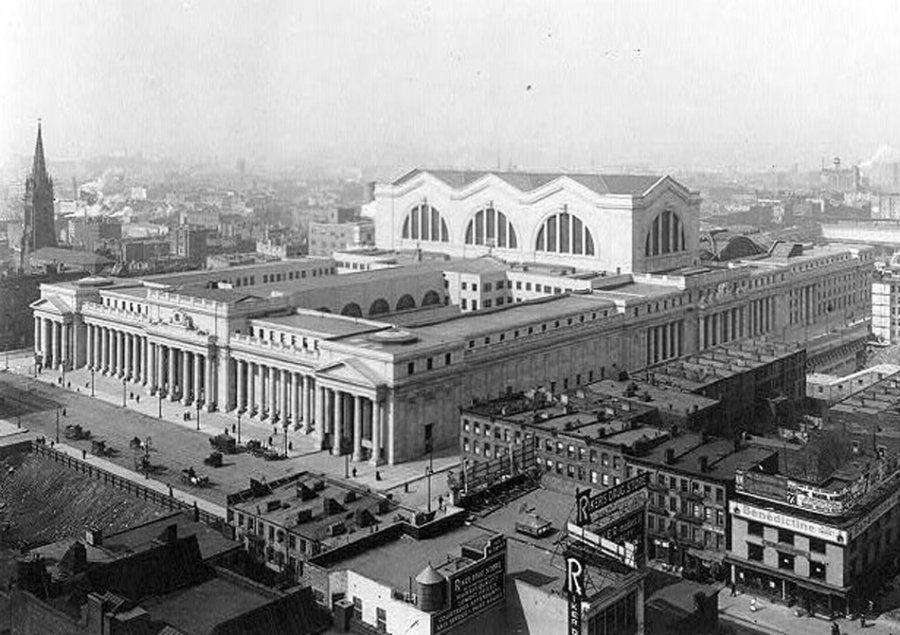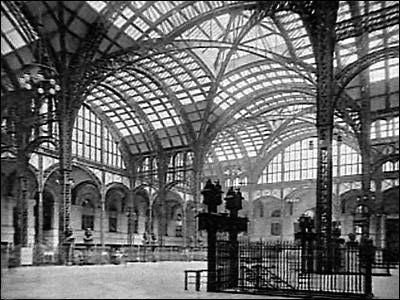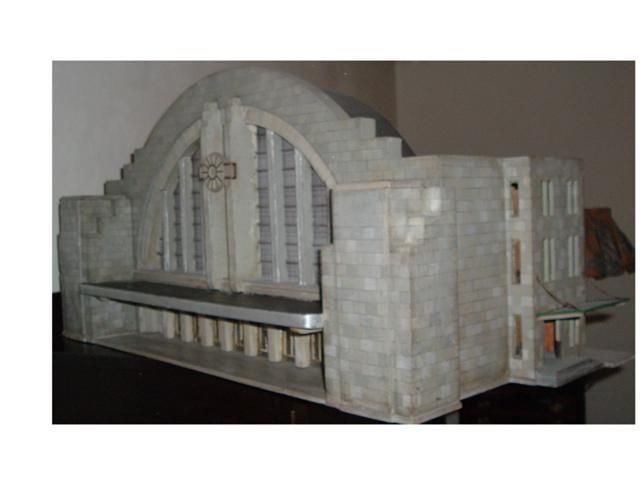Thanks Jason for spearheading the effort to get this terminal done. You picked the right guy to do it correctly.
Here is a photo of the first model of Cincinnati Union Station built by legendary model railroader Frank Ellison in the 1940's. Frank built this model while Union Station was still a very busy and active place. Today it is used by the Amtrak Cardinal and Hoosier state trains and is also a museum. This fine scale model is now in the hands of a collector in Northern Florida. It is constructed from Wood, Masonite and brass. The stone blocks are scribed and individually hand painted. Notice that the covered sheds to the sides that handled the car bus and trolley traffic (down and under the terminal)have been removed to save space. It must have been quite a place to depart from back in the day
I am considering making a "2D" version of the CUT with some added 3D details. This would be used as a "backdrop" but would be about 1/64th scale to allow use of readily available 1/64th vehicles.
I also have another project underway to build a "2D" version of the Kansas City Union terminal which is celebrating its 100th anniversary this year.
Attachments
Any news or updates on the model? I am curious about its final size. I am working on a layout and not sure I have the space required, but was curious how it was going.
Why did we ever stop designing our public buildings in the style of those built back in the day ? I have a great appreciation for the Classical and Art Deco styles. Even with our modern building materials we could replicate that type of construction with ease. And for those that say, why build in a style that has already been done, have a look at public buildings in the western democracies. They are all based on Greek Classical architecture.
Why did we ever stop designing our public buildings in the style of those built back in the day ?
Because a few snobs said they looked "ugly" and not en vogue and tore some of these beauties down to make way for "progress" RIP Penn Station, NYC!



Every time I'm reminded of the fait of Penn Station, I feel violated and nauseous.
All of these great terminals really should be preserved. And it would be fitting to replicate them on a train layout, but, I don't know about you guys, but my basement and my resulting 22' X 24' layout simply would not accommodate a station building of those proportions. Several years ago, I took another forum member's advice and assembled a "Union Station" from three MTH bank buildings. It's about 2' X 3' and sits above the six passenger tracks it serves. Point is: it still shares the size record for buildings on my layout with the engine house and the roundhouse. If it were any larger, it simply would not fit in it's allotted space, and would dwarf everything else anywhere near it on my main street and downtown. As it is, it still is pretty imposing.
I would certainly envy the guy whose layout could accommodate even a reduced size model of any of the major stations or terminals shown earlier on this subject. Of course, building such a model would probably be the one key subject of the entire layout.
Paul Fischer
Two people can enter the main concourse from the street. If one turns 90 degrees to the left, the other turns 90 degrees to the right and they continue to the South wall and North wall respectively, they can whisper to each other and be heard. The acoustics are such that the sound travels up and down the dome. John
Certainly no airport terminal I am familiar with has any sense of majesty and permanence as these RR terminals. Cincy, the inspiration for McDonald's Golden Arches?, has been through several iterations. I did not know it still operated as a railroad station. Yay for that!
I had the pleasure of departing and arriving at the station on a private car back in the mid 60's. I also rode in and out on coaches and sleepers several times. It was certainly a GRAND structure! I remember the time when the murals were moved from the station to the airport. What a job that was. I have two artifacts from the station, a track light, 14 North mounted over the doorway to my train room and a guide rail from the gate area. I also have a CUT hand lantern.
"Because a few snobs said they looked "ugly" and not en vogue and tore some of these beauties down to make way for "progress" RIP Penn Station, NYC!"
Oh my, how could I have failed to mention PennStation ! The station was what, fifty years old ? And to make way for a sports stadium it was demolished like someone throwing a cigarette butt in the gutter ? My blood pressure goes through the roof when I see documentaries about either the building of it or it's demolition, because I know, as I'm watching the building documentary, what is going to happen in the blink of an eye as structure lives go.
I think the demolition of Penn Station was the beginning of the preservation movement. And thankfully so. I graduated from Spring Garden College, in Philadelphia. Our professors were all professional architects and engineers. They were excellent at their job, in my opinion. However, their mindset was that buildings like City Hall in Philadelphia were eyesores.
One of the benefits of being a "senior" are the memories that accompany the passage of years. I remember going to the CUT in the 1950s with my parents and being awed by the magnificence of the architecture and its immense presence. Even now, my frequent visits always leave me with a wonderful sense of appreciation of its still elegant design, execution and preservation.
The model pictures are part of the museum display illustrating the evolution of various and significant areas in the development of Cincinnati from the early 1900s thru the 1950s.
Paul
Attachments
Attachments
Perhaps it has not only been Bill Gates, but others less successful such as myself who were out there in the herd staring at the guy in front of the blackboard, and thinking, "If you can't, teach". (that does not apply to all, for some in various levels of education are multi-skilled achievers) However, I certainly, today, can think of professors whom I did not and still do not, agree with. Styling, of buildings, or whatever, goes through fads. Some are impractical to bring back, others are timeless. Many of the ones found ugly by the "any change is good" society are historically important. (Maybe this does happen with airports, per my comment above....what did happen to the old Denver Airport before the new one was moved out on the prairie?)
Precisely. The Philadelphia International Airport of the 1950s was a benchmark design of the times. It has disappeared beneath a newer more sterile facade. Being old enough to have used the airport, before the transformations, I can still find some of the original architecture hidden beneath and behind the newer.





